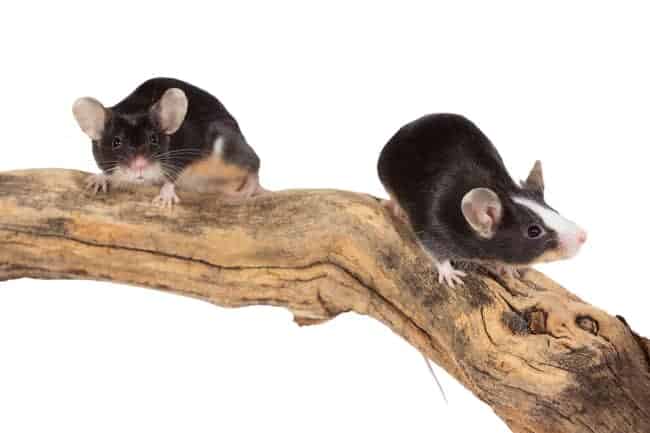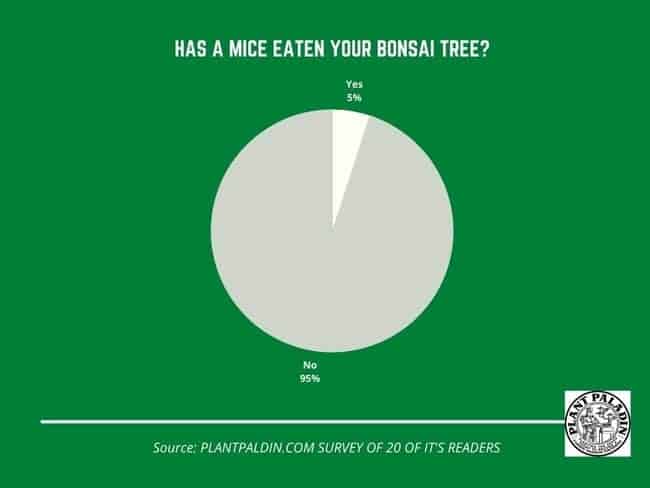This website is supported by its readers. If you click one of my links I may earn a commission. I am also a participant in the Amazon affiliates program and I will also earn a commission from qualified purchases.

One of the things I was most surprised about when I first started keeping bonsai was the number of pests I had to deal with. Insects like aphids and spider mites were commonplace but other animals such as slugs and birds would regularly attack my bonsai. With mice being so commonplace this got me thinking. Do mice eat bonsai trees?
Mice will eat the bark, leaves, and fruit of bonsai trees. They tend to eat bonsai trees during the winter when other food sources such as seeds or grains are hard to come by. Mice are particularly fond of deciduous bonsai species such as maple bonsai.
So why do mice eat bonsai trees? And what can you do to prevent mice from eating your bonsai? Keep reading to find out more.
Just a quick heads up, over the past three years of running Plantpaladin, hundreds of people have asked for product recommendations. As such, You can find my favorite indoor bonsai tree here (link takes you to Bonsaiboy), my favorite outdoor bonsai tree (link takes you to Bonsaiboy), or have a look at all the products I recommend here.
Do mice eat bonsai trees?
Mice infestations are amongst the most common pests that people have to deal with.
Lockdown restrictions have meant some exterminators seeing a massive 42% year-on-year rise of rodent infestations.
Any kind of pest infestation is worrisome for us bonsai keepers.
I wanted to get to the bottom of whether mice eat bonsai trees.
As such, I visited my local botanical gardens, did a quick survey of 20 plant paladin readers, and even called up a local exterminator.
Here is what I found:
- Mice will eat bonsai trees
- In particular, mice will eat the leaves, bark, fruit, and flowers of bonsai trees.
- Mice will tend to eat this during the winter months when their regular food sources of seeds and grains are harder to come by.
- It is not uncommon then for mice to break into greenhouses or bonsai cold frames and eat bonsai trees.
- Whilst mice will eat any kind of bonsai trees, in particular, they are a fan of delicious, leafy bonsai such as maple or ficus bonsai.
- Left unchecked mice can eat the entirety of a bonsai tree – it is not uncommon for bonsai owners to pack their bonsai away for winter only to check on them for the spring and be completely eaten.
- Mice also carry a myriad of diseases that can impact the health of people and bonsai trees alike so it is important you try and deal with these issues.
How to avoid mice eating bonsai trees?
If you are suffering from mice eating your bonsai trees, luckily there are a few solutions you can follow to prevent this from happening in the future.
To stop mice from eating your bonsai trees, keep mouse glue sheets near your bonsai trees, invest in a good mouse poison, and ensure you keep your bonsai tree in stainless steel, cast iron, or strengthened aluminum cold frame for the winter. Predatory animals can also be used.
Let’s explore these in more detail.
Invest in mouse traps
Often it can be difficult to figure out where exactly mice will attack your home.
Fortunately (or unfortunately) with mice eating your bonsai trees we know that sooner or later they will be near or around your bonsai trees.
As such one of the best options you can do to prevent mice from eating your bonsai is to simply lay down some sticky mouse traps around your bonsai tree pots.
These traps must be set at all angles.
Mice are incredibly clever and will learn from their past mistakes so ensure that your bonsai is completely covered in traps.
Now I prefer to use sticky traps as I find that they work best, however, if you prefer you can also opt for traditional spring-loaded mouse traps.
Keep peppermint oil near your bonsai
Now if you want to invest in a natural mice repellent that won’t kill mice then consider investing in peppermint oil.
Dowse some cotton balls in peppermint oil and lay these in the topsoil of your bonsai as well as around the pot.
Mice will not like this smell and it will cause them to not want to go near your bonsai in the future.
Build a metal cold frame
More often than not, mice will attack bonsai trees during the winter months, when their other food sources such as grains have dried up.
It’s not uncommon then for bonsai owners to store three bonsai trees in garages or polystyrene cold frame for winter only to check up on their trees and notice that the branches and bark have been shriveled up and eaten by mice
One of the best things you can do then is to build a bonsai cold frame out of steel, aluminum, or cast iron – these materials cannot be chewed by mice.
I found that often investing in something like a file cabinet does a fantastic job.
Now when building a cold frame you will need to have some holes to help maintain the temperature of your tree.
Just ensure that these holes are less than 5mm big as this is all the size a mouse needs to penetrate an object.
| Material | Will mice be able to chew through? |
| Cast iron | No |
| Stainless Steel | No |
| 316 Stainless steel | No |
| Aluminum | Yes |
| Oak | Yes |
| Plywood | Yes |
| MDF | Yes |
| Plastic | Yes |
Bonsai greenhouses are another good option – mice cannot chew through the glass as it will cause them significant harm, just be sure that if you do keep your bonsai tree in a greenhouse that you keep any doors or holes closed.
Invest in predators
Cats are the natural predators of mice.
Should you find an increased mouse infestation then consider keeping cats indoors to help you hunt mice and keep them from your bonsai trees.
Just be warned however that animals like cats and dogs can get sick eating bonsai trees so you will need to be vigilant.
Now if you keep a large bonsai collection outdoors then consider a natural predator like an owl that will easily take care of mice from eating your bonsai.
Use mouse poison
If you have tried the above methods and nothing is working then it might be time to call up an exterminator and get them to help use mouse poison.
Mouse poison works very well at stopping and killing mice, preventing them from eating your bonsai trees.
An exterminator will usually place this around your house, apartment, or garden, in the spots they suspect the mice to be coming from.
You can also tell them to lay a few pellets down in the topsoil of your Bonsai.
Just be warned that if you do decide to opt for this method, you do not use it if you have pets or young children who can be susceptible to eating the pellets.
Remove insects
Whilst mice are usually omnivores, they have been found to eat insects such as grasshoppers or caterpillars.
As such, it’s important to avoid any insects from your bonsai tree, giving the mice less of a banquet to feast on in and around your plant.
I found that using a solution of 2 tablespoons of liquid soap with 30 oz of water usually works best for this.
For a full guide, check out my post or removing insects here for checking out the following posts:
- Aphids on bonsai
- Do caterpillars eat bonsai
- Do frogs eat bonsai trees
- Bonsai trees and birds
- Do slugs eat bonsai trees
- Scale on bonsai
- Spider-mites on bonsai

Chose different bonsai species
Whilst mice will eat pretty much any bonsai tree, should your bonsai sprout flowers or bare fruit then they will prefer to eat these types of bonsai.
Avoiding leafy bonsai species such as maple will also work well – mice love to eat maple trees both large and small.
I’d recommend investing in evergreen bonsai species such as pine or juniper – the needle-like leaves will make it more difficult for mice to eat.
Alternatively, the leaves of oak trees are toxic to mice and so they will avoid eating your tree should you keep an oak bonsai.
I’d also avoid keeping smaller-sized bonsai such as fingertip bonsai, or bonsai cuttings and seedlings.
This is because should mice start to eat tiny bonsai trees, there will be a much greater chance of mice destroying your tree in its entirety.
What part of bonsai trees do mice eat?
Mice will eat the fruit, leaves, bark, flowers, and seeds of bonsai trees. Smaller bonsai cuttings and seedlings are more at risk of being eaten by mice. Bonsai trees with more leaves or more branches such as maple will be more likely to be eaten.
Are bonsai trees poisonous to mice?
American yew and wormwood are two tree species that are toxic to mice that can be used for bonsai. Oak and bay leaves are also toxic to mice and so oak tree bonsai can deter mice.
Why do mice eat bonsai trees?
Mice eat bonsai trees when other food sources such as grains and seeds have dried up. This most commonly happens during the winter as mice find their way indoors to find quick and easy sources of food.
What happens if you do not remove mice from bonsai trees?
Mice have been known to carry several diseases and fungi that can damage bonsai trees. It is not uncommon for bonsai trees to develop fungal infections, usually displayed by white spots on bonsai leaves, after interacting with mice.
What bonsai species do mice like to eat?
Mice will eat almost all species of bonsai tree. Mice do tend to eat leafy, deciduous bonsai tree species such as maples trees, ficus, or elm trees. They will avoid oak bonsai trees as they are toxic.
Do mice eat bonsai trees? Survey
Now I didn’t want to just highlight my findings of if mice eat bonsai trees but wanted to give a few other experts advice.
First I got in touch with my local council and asked them if mice eat bonsai trees – here was their response:
“Mice are opportune and will eat anything given the opportunity.”
Finally, I asked 20 plant paladin readers their thoughts on if mice had eaten their bonsai trees – here were the results:

A lot of you reading this will be new to keeping bonsai so I would recommend you check out the following posts:
- Bonsai trees and rainwater
- Bonsai trees and sunlight
- Sacrifice bonsai branch
- How to use bonsai humidity trays
- How long do bonsai trees live
- Are bonsai trees toxic
- Health benefits of bonsai
My top picks for the gear you will need!
So like I mentioned earlier, over the past three years of running PlantPaladin, hundreds of people have asked me for my recommendations on the best bonsai gear on the market.
Having spent thousands of dollars on bonsai items these past few years and tested at least 100 bonsai-specific products, I’ve listed my favorite products below – All of which I highly recommend and think you can get great value.
They can purchase directly by clicking the link to take them to Amazon.
Bonsai Tool Set: One of the significant challenges I’ve had is finding a toolset that was not only durable but didn’t break the bank. SOLIGT has recently developed a fantastic bonsai tool set that covers all the tools you need to trim, prune, and repot your trees. – You can grab it here.
Complete Bonsai Set: Many of you will want to grow your bonsai trees entirely from scratch, but finding the varicose seeds, pots, and other items in one place can be challenging. Leaves and Sole then have created a complete bonsai set that I’ve personally used that ticks all the boxes. You can grab it here.
Bonsai wire: The number of times I’ve run out of wire for my bonsai or purchased cheap bonsai wire that doesn’t do the job is embarrassing for me to admit. After a lot of trial and error, I found that using Hotop’s aluminum bonsai wire is one of the best options on the market. This can easily be used for both indoor and outdoor bonsai. You can grab it here.
This post was written by Fehed Nicass who has been passionate about bonsai for over 2 years. He currently resides in the UK and works in sales.

